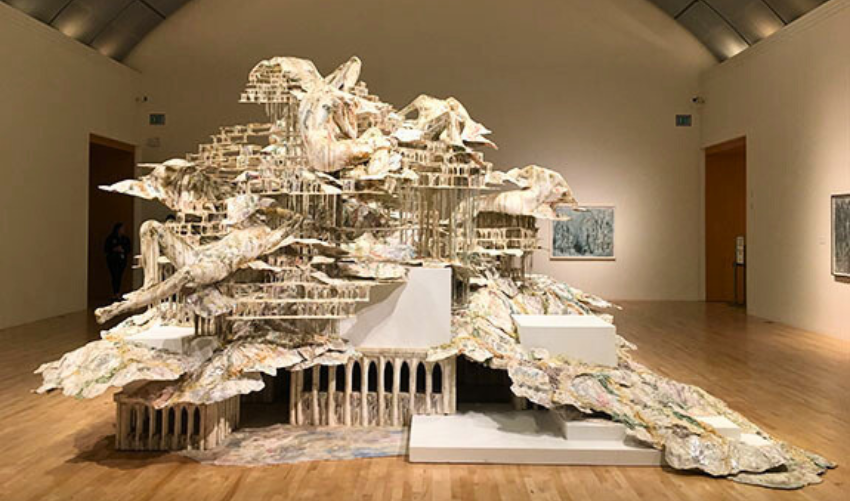Al-Hadid’s work is not just a visual experience; it’s a thought-provoking exploration of identity, culture, and the intricacies of human experience. As you read on, you’ll uncover the layers of meaning behind this remarkable creation. You’ll discover how Al-Hadid blends different influences to craft a narrative that resonates deeply.
If you’ve ever wondered how art can spark conversations and evoke emotions, this article is for you. Let’s explore what makes “Nolli’s Orders” a must-see in today’s art scene. You won’t want to miss it!
Artistic Vision
Nolli’s Orders by Diana Al-Hadid showcases a unique artistic vision. The work reflects a blend of historical influences and contemporary themes. It invites viewers into a world where architecture and memory collide.
Creative Process
Diana Al-Hadid’s creative process is intricate and thoughtful. She often combines different materials to convey her ideas. This approach helps her express complex themes. Her works often include:
- Bronze
- Plaster
- Wood
- Glass
Each material adds depth to her art. The combination creates a dialogue between old and new.
Influences And Inspirations
Al-Hadid draws inspiration from various sources. Historical architecture plays a significant role. She also looks at:
- Literature
- Mythology
- Personal experiences
These elements shape her vision. They help her create pieces that resonate with audiences.
Themes Explored
Her work explores several important themes:
- Memory
- Identity
- Displacement
Through her art, Al-Hadid examines how these themes affect individuals and communities. She encourages viewers to reflect on their own experiences.
Visual Language
Al-Hadid’s visual language is powerful. She uses form and texture to communicate ideas. Her pieces often feature:
| Element | Description |
|---|---|
| Line | Fluid and dynamic, guiding the viewer’s eye. |
| Shape | Organic forms that suggest movement and change. |
| Color | Subtle hues that evoke emotion and memory. |
This visual language invites interaction. Viewers engage with her work on a deeper level.

Cultural Influences
Nolli’s Orders by Diana Al-Hadid is a thought-provoking work that explores the blend of different cultures. The artwork reflects various traditions and histories. It invites viewers to think about how culture shapes identity and community.
Cultural Context
The cultural context of Nolli’s Orders is rich and layered. Al-Hadid draws from her background and experiences. Her work reflects a mix of Middle Eastern and Western influences. This combination creates a unique narrative.
- Middle Eastern Heritage: Al-Hadid’s roots play a big role in her art.
- Western Art Traditions: She also incorporates elements from Western artists.
- Historical References: The piece includes references to historical events and figures.
Symbolism In The Artwork
Symbolism is key in Nolli’s Orders. Al-Hadid uses symbols to convey deeper meanings. Each element in the artwork tells a story.
| Symbol | Meaning |
|---|---|
| Architecture | Represents cultural heritage and identity. |
| Figures | Show the diversity of human experience. |
| Materials | Reflect the fusion of different cultural practices. |
Impact On Viewer Perception
Viewers experience a shift in perception while engaging with Nolli’s Orders. The cultural influences prompt reflection. People start to think about their own identities and backgrounds.
- Encourages self-reflection on personal culture.
- Promotes understanding of diverse backgrounds.
- Fosters dialogue about cultural connections.
Nolli’s Orders is not just art. It is a conversation starter. It challenges viewers to explore how culture shapes lives.
Material Choices
Nolli’s Orders by Diana Al-Hadid is a fascinating exploration of material and form. The artist uses various materials to create a unique experience. Each choice reflects a deep connection to the themes of the work.
Exploring Diverse Materials
Diana Al-Hadid employs a mix of materials in Nolli’s Orders. Each material tells a story. Here are some key materials used:
- Plaster: Soft and moldable, it allows intricate shapes.
- Steel: Provides strength and contrast to softer materials.
- Glass: Adds transparency and lightness to the pieces.
- Wood: Brings warmth and an organic feel.
Meaning Behind Material Choices
Each material carries its own significance. Al-Hadid chooses materials that reflect the themes of her work:
- Identity: Materials symbolize personal and cultural histories.
- Fragility: Some materials represent the delicate nature of existence.
- Strength: Others showcase resilience and durability.
Impact On Viewer Experience
The materials create a unique viewer experience. They engage the senses and provoke thought. For instance:
| Material | Viewer Impact |
|---|---|
| Plaster | Invites touch and exploration. |
| Steel | Conveys a sense of stability and strength. |
| Glass | Offers a glimpse into fragility. |
| Wood | Encourages a connection to nature. |
Themes Of Identity
The work reflects how identity shapes our lives. It shows how culture, history, and personal experiences intertwine. Al-Hadid uses her art to question what makes us who we are. This blog section will dive into these themes.
Identity And Culture
Culture plays a vital role in shaping identity. In Nolli’s Orders, Al-Hadid highlights this connection. She examines how cultural background influences personal identity. The artwork features elements from various cultures. This blend creates a rich tapestry of identities.
- Integration of historical references
- Use of diverse materials
- Influence of different artistic styles
Personal Vs. Collective Identity
Nolli’s Orders contrasts personal and collective identity. Individual experiences shape who we are. At the same time, society influences our identities. Al-Hadid captures this duality in her work. Each piece tells a personal story while reflecting broader themes.
- Personal stories are unique.
- Collective experiences bind communities.
- Art reflects both aspects of identity.
Identity In Transition
Identity is not static. It evolves over time. Al-Hadid’s work illustrates this change. Characters in Nolli’s Orders go through transformations. They face challenges that reshape their identities.
| Transformation Stage | Impact on Identity |
|---|---|
| Initial Struggles | Questioning self-worth |
| Facing Adversity | Gaining strength |
| Embracing Change | Finding true self |
Identity And Memory
Memory shapes our identity. Al-Hadid connects memory to identity in her art. She shows how past experiences influence the present. The work invites viewers to reflect on their memories. This reflection helps define who we are.
- Memory can be painful.
- Memory can be a source of strength.
- Shared memories create bonds.
Historical Context
Nolli’s Orders by Diana Al-Hadid is a captivating work that explores themes of history, identity, and architecture. The piece draws from a rich historical context that influences its meaning.
Historical Background Of Nolli’s Orders
The concept of Nolli’s Orders stems from the 18th-century map by Giovanni Battista Nolli. This map depicted Rome in a unique way. It highlighted public and private spaces, changing how people viewed the city. Al-Hadid uses this map to inspire her work.
The Influence Of Architecture
Architecture plays a significant role in Nolli’s Orders. Al-Hadid examines how structures shape our experiences. The work reflects on:
- Historical architecture
- Modern urban design
- Public versus private spaces
These elements provoke thought about how we interact with our environment. They challenge the viewer to consider their place in the city.
The Role Of Memory And Identity
Memory and identity are central themes in Al-Hadid’s work. She connects personal and collective memories to historical contexts. This connection helps viewers understand:
- The impact of history on identity
- The shared experiences of communities
- The importance of remembering the past
Through her art, Al-Hadid encourages reflection on how history shapes who we are today.
Cultural Significance
Nolli’s Orders is not just about Rome. It speaks to global issues of displacement and belonging. Al-Hadid’s work resonates in various cultural contexts. It reminds us of the universal struggle for identity. This significance makes the work relevant beyond its historical roots.
The historical context of Nolli’s Orders enriches the viewer’s experience. It invites exploration of complex themes like architecture, memory, and identity.




